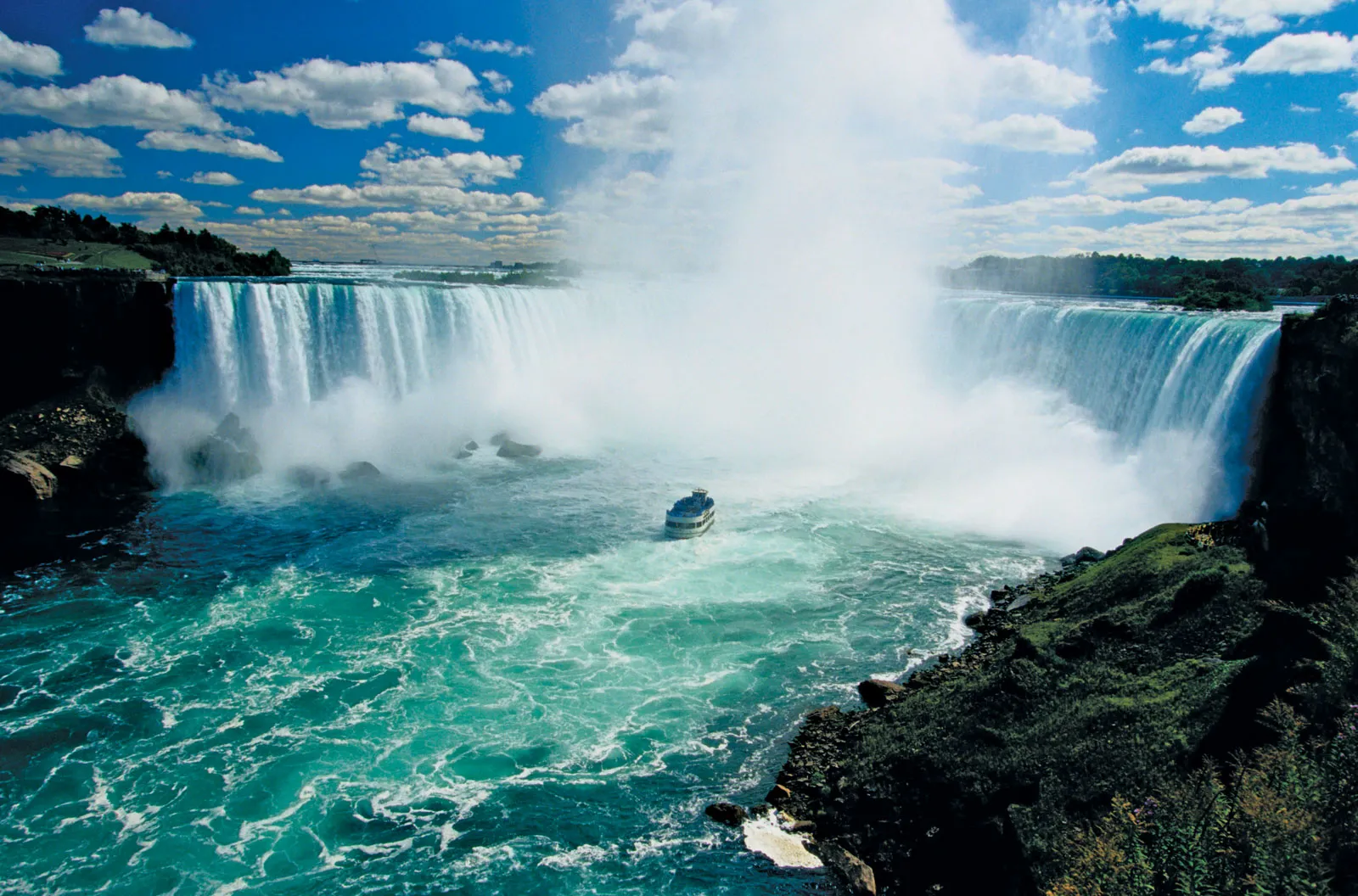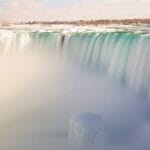Ever wondered what makes Niagara Falls so incredibly powerful? It’s a question that has likely captivated countless visitors who have witnessed its awe-inspiring force. The answer lies in a delicate balance of geography, hydrology, and natural processes that have shaped this natural wonder over millennia. Let’s explore the secrets behind Niagara Falls’ awe-inspiring water flow.
How does Niagara Falls have so much water?
The sheer volume of water cascading over Niagara Falls is a sight to behold. Where does it all come from? The answer is a testament to the interconnectedness of our planet’s water systems: the Great Lakes.
Niagara Falls is fed by the Niagara River, which serves as a crucial link between four of the five Great Lakes: Superior, Michigan, Huron, and Erie. Together, these majestic lakes hold a staggering 18% of the world’s surface freshwater – a true testament to their immense scale. Imagine a gigantic basin spanning over 900,000 square miles, collecting rainfall and snowmelt from countless rivers and streams – that’s the impressive network feeding the Great Lakes.
It’s important to note that Niagara Falls doesn’t tap into the entirety of all five Great Lakes. Instead, it receives its flow from the combined waters of Lakes Superior, Michigan, Huron, and Erie, which ultimately flow into Lake Ontario via the Niagara River.
But the Niagara River isn’t merely a conduit. As the river courses towards Lake Ontario, it encounters a dramatic drop of roughly 160 feet between Lake Erie and its final destination. This steep incline acts as a natural water slide, propelling an immense volume of water towards Niagara Falls with breathtaking speed and force. Every second, approximately 685,000 gallons of water thunder over the falls – a volume equivalent to emptying 2.6 million one-liter bottles every single second!
This continuous flow is not only a spectacle; it plays a vital role in maintaining the health of the entire Great Lakes system. Niagara Falls acts as a massive, natural regulator, helping control water levels in the lakes and mitigating the risk of flooding. This delicate ecological balancing act is essential for the diverse ecosystem that relies on the Great Lakes, including numerous fish species that depend on the falls’ currents for migration and breeding.
Why is there so much water in Niagara Falls?
The answer to this question circles back to the primary source: the Great Lakes. Holding approximately 20% of the Earth’s surface freshwater, the Great Lakes serve as a colossal reservoir, constantly replenished by a vast network of tributaries.
The Niagara River, although relatively short at only 36 miles in length, carries the immense responsibility of channeling water from Lake Erie to Lake Ontario – a task it performs with remarkable efficiency. Every second, the river transports a staggering 240,000 cubic feet of water, a volume comparable to emptying an Olympic-sized swimming pool over the falls every other second.
It’s crucial to acknowledge that while the Great Lakes act as the primary source, the Niagara River’s flow is further augmented by a network of smaller rivers and streams that join its course. These tributaries, much like veins in a circulatory system, ensure a consistent and powerful flow of water towards Niagara Falls, regardless of seasonal variations.
Where does Niagara Falls get its drinking water?
While the term “drinking water” might not be entirely accurate in this context (it’s not recommended to drink directly from Niagara Falls!), the question of where this massive waterfall gets its water is an intriguing one. The answer lies in understanding the interconnectedness of the Great Lakes system.
Lake Erie, the final lake in the Great Lakes chain, serves as the direct source of water for Niagara Falls. Picture Lake Erie as a giant spout, continuously pouring water into the Niagara River, which then carries it towards the iconic falls. But Lake Erie itself is not a self-filling reservoir. It receives its water from the upstream Great Lakes – Superior, Michigan, and Huron – forming a natural chain of interconnected waterways.
These upstream lakes receive their water from various sources, including precipitation in the form of rain and snow, as well as groundwater that seeps into the lakes over time. This intricate system ensures a continuous flow of water through the Great Lakes and ultimately over Niagara Falls.
Why is Niagara considered to be the most powerful waterfall?
Niagara Falls isn’t just impressive; it’s often hailed as the most potent waterfall in North America, and for good reason. While height plays a role in a waterfall’s power, the true measure lies in the combination of volume and flow rate, and Niagara Falls excels in both.
With access to the vast freshwater reserves of the Great Lakes, which contain roughly 20% of the world’s total, Niagara Falls boasts an incredible and consistent water supply. This translates to a mind-boggling flow rate surpassing 168,000 cubic meters of water per minute – a volume difficult to comprehend fully. Imagine 168,000 bathtubs emptying their contents every minute – that’s the sheer scale of Niagara’s water flow.
However, it’s crucial to note that the concept of a waterfall’s “power” can be subjective and may change as our scientific understanding evolves. Factors beyond height and flow rate, such as geological formations, erosion patterns, and even the shape of the falls, can contribute to its overall power.
How do they stop the water going over Niagara Falls?
While fully “stopping” the water flow over Niagara Falls might seem like an impossible feat, humans have developed ingenious engineering techniques to temporarily manage and redirect its flow. This is primarily done for maintenance, preservation, and scientific study.
One such method involves the construction of massive structures called “cofferdams.” Imagine a gigantic, reinforced wall strategically built upstream from the falls, effectively acting as a temporary dam. Cofferdams, often composed of large rocks, steel beams, and other robust materials, are designed to redirect the river’s flow temporarily. This allows engineers to access the usually submerged riverbed for crucial maintenance and research.
Historically, cofferdams have been instrumental in studying the geological formations that underlie Niagara Falls. In 1969, a cofferdam was erected, offering geologists an unprecedented opportunity to examine the rock formations beneath the American Falls, providing valuable data on erosion patterns and potential preservation strategies.
Beyond cofferdams, engineers utilize intricate control structures to fine-tune the volume of water flowing over certain sections of the falls, like adjusting a giant valve. This careful management helps mitigate erosion and preserve the falls’ natural beauty.
In some instances, temporary shutdowns of specific sections of Niagara Falls are necessary for major maintenance, repairs, or in-depth inspections. These shutdowns, though infrequent, are meticulously planned to minimize disruption and are usually timed during periods of lower tourist activity.
While completely halting the natural wonder that is Niagara Falls might be beyond our capabilities and perhaps even undesirable, it’s a testament to human ingenuity that we’ve found ways to manage, protect, and better understand this natural wonder.
If you’ve ever wondered how does Niagara Falls not run out of water, then you’re not alone. This natural wonder has been flowing for thousands of years, and it shows no signs of stopping anytime soon.
- Star Ring Trends: Etsy vs Amazon - March 28, 2025
- Boost Pollinator Habitats: Baby Blue Eyes Sustainable Farming Guide - March 28, 2025
- Protect Big Black Bears: Effective Conservation Strategies - March 28, 2025

















1 thought on “The Hydrological Majesty: Unraveling the Source of Niagara Falls’ Immense Water Flow”
Comments are closed.